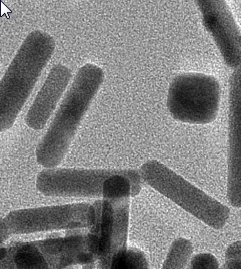Gold nanorod mass-production
06 March 2011 - Nanotech
 In one of the many applications envisioned for gold nanorods they are introduced into the human body, anchor themselves to an ugly cancerous tumor and kill it when illuminated by a laser beam they heat up and puncture holes in it. Obviously for such a noble cause more of these gold nanorods are needed and a group of Australian researchers have proposed a way to scale up nanorod production (Bullen et al. DOI). In their recipe a mix of chloroauric acid, cetrimonium bromide and reducing agent acetylacetone is mixed with a mix of cetrimonium bromide and silver nitrate buffered by sodium bicarbonate / sodium carbonate. The first mix will produce nanogold particles all by itself but the silver in the second mix is needed for the correct rod aspect ratio. For continuous production the researchers devised a reactor featuring a stainless steel rotating (up to 2000 rpm) cylinder for mixing and a 20 meter silicone tube for particle growth. Of course a lot of tinkering was required before getting acceptable results: rotation speed, reactor residence time, temperature and the gold to silver ratio. In the end the desired nanorods on average measure 6 nm by 20 nm with 300 micron thickness. Another novelty the researchers introduce is that the production is seedless. Now this might be tricky to monitor and this blog is having some doubts: if you are in nanoparticle research the laboratory will eventually be dusted with nanoparticles from top to toe and there will no longer be any need for additional seeding experiments.
In one of the many applications envisioned for gold nanorods they are introduced into the human body, anchor themselves to an ugly cancerous tumor and kill it when illuminated by a laser beam they heat up and puncture holes in it. Obviously for such a noble cause more of these gold nanorods are needed and a group of Australian researchers have proposed a way to scale up nanorod production (Bullen et al. DOI). In their recipe a mix of chloroauric acid, cetrimonium bromide and reducing agent acetylacetone is mixed with a mix of cetrimonium bromide and silver nitrate buffered by sodium bicarbonate / sodium carbonate. The first mix will produce nanogold particles all by itself but the silver in the second mix is needed for the correct rod aspect ratio. For continuous production the researchers devised a reactor featuring a stainless steel rotating (up to 2000 rpm) cylinder for mixing and a 20 meter silicone tube for particle growth. Of course a lot of tinkering was required before getting acceptable results: rotation speed, reactor residence time, temperature and the gold to silver ratio. In the end the desired nanorods on average measure 6 nm by 20 nm with 300 micron thickness. Another novelty the researchers introduce is that the production is seedless. Now this might be tricky to monitor and this blog is having some doubts: if you are in nanoparticle research the laboratory will eventually be dusted with nanoparticles from top to toe and there will no longer be any need for additional seeding experiments.
In any event the researchers are confident and in their Chemical Communications report they state they will eventually reach 100 kg scale production required to hypothetically furnish every person on the planet with a single 10 nm thick, 2.25 cm square monolayer of particles. So for the near future watch your mailbox for a very tiny parcel with an even tinier postage stamp from Australia.
